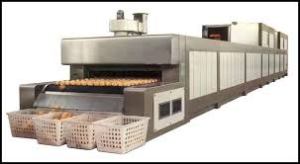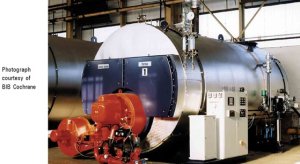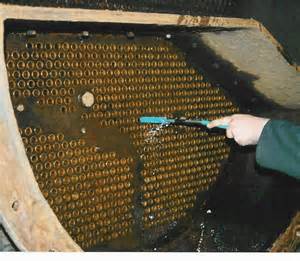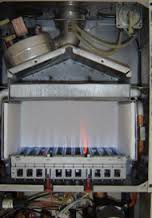A Holistic Approach.
I’ve often suggested that it is important to get as overall a picture as possible not only understanding how much energy is used but where it is used and most importantly WHY it is used.
While I was at Leicester a local bakery spent over £100,000 on a heat recovery system from their ovens to provide space heating (that was when £100k was a significant amount of money) and in the process saved 38% of their gas bill. That made them a nominee for a regional Gas Energy Management award (GEM – I have a nice set of ties from that then annual contest). That they didn’t even win the regional award let alone the national one shows the standard of projects being supported by British Gas at that time.
Well their radical steps meant that they had effectively no load for their rather large steam boilers, for example a few instantaneous water heaters dealt with the hygiene demands and a point of use steam boiler handled the “proving” of the dough. There was one significant problem however. The process produced a large number of baking trays that needed cleaning.
I , as British Gas, dutifully produced a quotation for a gas boiler, my colleague from the EMEB did likewise for an electric equivalent and other contractors quoted for other heating methods (before the days of renewable energy) but the Works Engineer came up with the best solution which has stuck with me from then on. He went off and obtained cold water detergent and successfully used that to clean the trays.
He thereby eliminated the need to heat water entirely at no capital cost and only a very slightly higher consumable cost (much less than the cost of the energy used to heat the water)
And that is the best approach to energy management – completely eliminate the usage if possible by examining WHY the usage was required and eliminating that for which there was no need.
Saying What I Think Again
Sometimes a failure from someone to change what you’ve written can be the problem. After leaving the MOD world I joined a facilities management company. My first project was to examine the usage of a large IT company (a household name) and specifically the performance of the air conditioning and I duly surveyed the site with another experienced engineer. All was basically well (a few anomalies in the BMS readouts) until we got onto the roof of the first block (there were three). We removed the cover from the condenser and couldn’t recognise what we were seeing. Rather than seeing a heat-exchanger with fins or some sort of matrix (like a car radiator) we saw what looked like two sheets of grey chipboard.
We reached out and passed a finger along the board. It was caked with dirt completely blocking the air flow – no wonder the performance of the chiller was unsatisfactory! Trouble was my new employers were responsible for the maintenance (and this clearly had NEVER been cleaned) of the air conditioning and had just received an order for £250,000+ to replace the units on the adjacent building which had recently completely failed. (it was now obvious why).
What was I to do? After telling the maintenance team to get the hoses out and get the condensors cleaned as soon as possible we rang the boss. We explained the situation to him and asked what we should write in our report. He told us that our report had to be truthful and accurate and that we should as a policy ALWAYS write it “warts and all” even if it showed our business in a bad light. He would personally make sure that the report was suitably censored before it was allowed to reach the client.
Driving back I realised that poor maintenance could also explain one of the anomalies we’d noticed on the BMS. Air was being chilled to 5C before being distributed around the building and reheated to a more appropriate temperature before being passed into the occupied space. 5C however was a far lower figure than we expected to see and represented an significant additional energy cost to a more normal 15C. The reason for that was suddenly apparent, if they haven’t serviced the condenser they probably haven’t serviced the heat emitters and they’re probably fouled as well (logic was that the BMS would have learnt that the cooling wasn’t having the designed effect and progressively lowered the air temp to obtain it ).
The Facilities Manager was sent to check one of the less accessible parts of the system and he soon reported back that it was also filthy.
The moral is that maintenance is in the schedules for a reason and if you don’t do it to the correct level equipment will not perform as intended or fail prematurely at great cost. In this instance the cost was to me! My boss forgot to edit the report (despite my marking it draft and including a message not to be shown to the client in the covering email) and presented it to the client unaltered. I was therefore a marked man and an excuse was found to release me soon after – I was too honest apparently.
Summertime
 And the living is easy – with all due respect to George Gershwin that “ain’t necessarily so” for energy managers. OK the clients aren’t all complaining that they’re “freezing” and sitting in the dark but there will be a number who are complaining that they are too hot. (I will never understand why people who demand 23C in winter also demand 17C (well they’d probably find 19C acceptable) the moment the sun shines . As 1C equates to something like 10% of usage their preferences add over 20% to the annual energy bill compared to holding at 21C for occupied time in both Winter & Summer – and some would argue that that figure is “too comfortable”).
And the living is easy – with all due respect to George Gershwin that “ain’t necessarily so” for energy managers. OK the clients aren’t all complaining that they’re “freezing” and sitting in the dark but there will be a number who are complaining that they are too hot. (I will never understand why people who demand 23C in winter also demand 17C (well they’d probably find 19C acceptable) the moment the sun shines . As 1C equates to something like 10% of usage their preferences add over 20% to the annual energy bill compared to holding at 21C for occupied time in both Winter & Summer – and some would argue that that figure is “too comfortable”).
There will be some who are complaining that the sun is so bright they cannot see and they can’t turn off the lights because they’re on presence detectors (that is something that you can do something about by using photocells to dim the lights and/or including “off” switches but see “But it is Saving Energy”)and maybe the blinds don’t close.
 Perversely there will be some people who are still cold either because of draughts or because they are right next to the cooling source for a lot of hot people. There will be others for whom the noise of the ventilation plant is distracting. The complaints don’t stop when the Sun comes out.
Perversely there will be some people who are still cold either because of draughts or because they are right next to the cooling source for a lot of hot people. There will be others for whom the noise of the ventilation plant is distracting. The complaints don’t stop when the Sun comes out.
Now my first question for the energy managers out there; does your company have a clear policy for the use of Air Conditioning; does it specify settings? Or can anyone turn it on at any setting they desire?
When I was with the MOD the rule was clear “Air Conditioning is not required for personnel in the Northern Europe Theatre of Operations; any fitted is for the protection of equipment” –not that it worked like that but there was a policy to which we could point.
OK so people demand AC these days (probably partially the affect of something it helps cause; “Global Warming”) so does your company have a policy on how and When AC should be installed and how it should be used?
What temperature do you set the AC to deliver? Two relevant factors to take into account 1) the lower the temperature the more energy will be used 2) the closer the original temperature to the set temperature the more efficient will be the cooling (ask a Thermodynamacist to explain). So I would suggest that you mandate a maximum level of cooling (that is a minimum temperature). But what should that temperature be? Well there is no clear maximum temperature that someone should work in (there is still I believe a maximum temperature (19C) to HEAT a building to under a Statutory instrument from1984 – I don’t think it got repealed after a consultation last year- but that is ignored in the main). The only authoritative document is one from the World Health Organisation stating that no-one should be expected to work “continuously” in a temperature of over 25C. So that is your answer set your AC to 24.9C the AC will rarely run in the UK you will use very little energy and no-one can complain!
Seriously, that obviously won’t work: people’s expectations are more exacting if possibly unreasonable (urban myths about vagrants dying of hypothermia in Californian shopping malls come to mind). Realistically I’d opt for 23C as the set point and accept 21C resisting hard anything lower but you may need to compromise more.
I recently noticed that on one of my schools (which suffered badly from the cold in the winter) that the server room was reporting a temperature of 14.5C. When I pointed that out to the IT experts (with the comment that the temperature is low enough to cause condensation and damage the servers that way)they said “that’s too low set it to 21C “ (I’d expected 19C!) so I set it to 22C and the BMS now reports 18.5C.
That the insulation to that room is poor and it has clearly been stealing heat from an already cold school is one of my tasks for Summer!
Summertime should be a time of lower energy use in the temperate climbs but it can still present issues for the energy manager – more to come….
What makes a miracle worker?
 I’ve sometimes been called a miracle worker (but not in the league of the lady above). Often by doing things quicker than expected or by solving problems that others had failed at. The comment “that only took you 5 minutes” was often followed by the thought “no 10 years and 5 minutes” (or whatever period of learning/experience I felt relevant). Sometimes dumb luck was involved or just a willingness to address the problem and not run away.
I’ve sometimes been called a miracle worker (but not in the league of the lady above). Often by doing things quicker than expected or by solving problems that others had failed at. The comment “that only took you 5 minutes” was often followed by the thought “no 10 years and 5 minutes” (or whatever period of learning/experience I felt relevant). Sometimes dumb luck was involved or just a willingness to address the problem and not run away.
I remember being called out when at Leicester by a service engineer who thought he was out of his depth on a job. “It’s industrial I’m not trained on Industrial”. Rather than just taking over (that would have profited no-one) I calmed the engineer and invited him to work with me to sort it – to his credit he readily agreed.
The device was a natural draught industrial oven (8ft cube more or less) and it was that size that had worried the service engineer. But with my support he rapidly identifies the gas components. There was a bar burner (he’d handled lots of those albeit a little shorter), a thermoelectric valve (like most domestic boilers). A relay valve (lots of boilers), a pilot light (like gas fires and cookers) and a gas thermostat – like domestic ovens.
So there was no actual component that he wasn’t familiar with and he was soon able to spot that the thermocouple was burnt out – he carried those in his van!
On another occasion it was me who was perplexed. I was presented with another much larger industrial oven which everyone (and that was a significant number) had failed to make work properly. I had the manual and progressively worked through the settings ; finding (as one might expect) them exactly right. However the whole thing did not seem to have enough oomph it just didn’t seem forceful enough to work properly significantly I wasn’t seeing the air movement or pressure I expected.
I went to speak to the electrician who told me it was working fine when he picked it up from its previous home. “Maybe the fans got broken in transit” He was adamant that all must be right as the air was moving in the right direction – just not enough of it.
That had me thinking – it’s a 3 phase supply isn’t it? Remembering that getting two phases reversed will make the fans turn the opposite way I asked the electrician to “humour me” and switch any two of them over.
He did and I threw the contactor. Everyone working in the factory turned in my direction. The sound from the air moving through the oven was hundreds of times greater because there was hundreds of times more air moving through the oven! And now it worked properly.(what the site electrician didn’t know is that many fans will move air in the right direction even if going backward)
I actually got a letter of appreciation from the client to my management praising my clear thinking and experience ( all of 5 years then!) and reciting the number of “engineers” (his speech marks) who’d failed and how much they’d cost him.